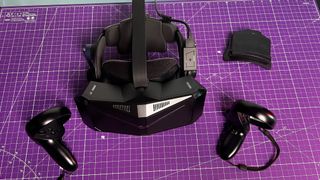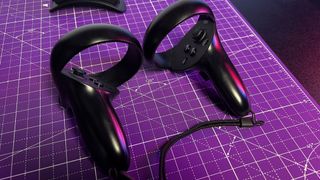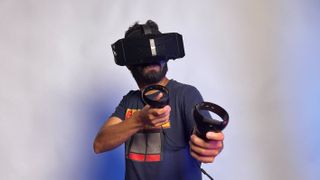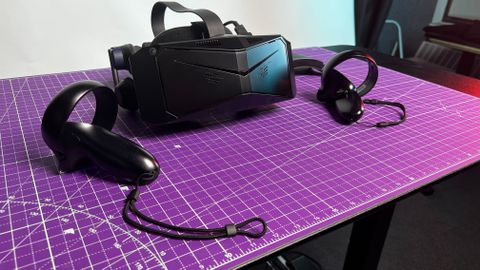Our Verdict
The Pimax Crystal feels like a work in progress. It's one of the most powerful VR headsets I've used, but it doesn't matter when it isn't getting the basics right, or is releasing without key features ready. At $1600, I expect so much more.
For
- Great visuals, nice wide FOV
- Swappable Batteries
- Adjustable IPD settings
Against
- No passthrough
- Standalone/Streaming doesn't work yet
- Eye Tracking doesn't work
- Poor hand tracking in SteamVR
- Set up issues
- Expensive
PC Gamer's got your back
As far as VR gaming is concerned, there are two distinct paths a VR headset can take. One is to go affordable and lightweight—compromising high-end visuals for accessibility and lower cost—and the other is to cram every feature you can imagine, and cost be damned. At $1,600, guess which camp the Pimax Crystal falls into.
On paper, the Pimax Crystal was supposed to be the ultimate gaming VR headset, promising to rival the Meta Quest Pro in performance and even challenge the unreleased Apple Vision Pro with its impressive glass lenses and 8K resolution. However, in reality, it's turned out to be truly disappointing. Using the darn thing requires a lot of effort and a whole lot of patience.
As someone who recently embraced VR, one of my biggest gripes has been the lack of visual fidelity and performance compared to PC gaming. Trying out the Pimax Crystal made me realize powerful visuals and performance are great, but you're left with a frustratingly bad (and very expensive) user experience without key functionality. Much like the HTC Vive XR Elite, another high-end wireless VR headset, the Pimax is trading in function and usability for raw power.
Before I delve into the extensive list of issues I encountered with the Crystal, some positive aspects are worth mentioning. Starting with the display, the glass aspheric lens with 35 pixels per degree (PPD) peak fidelity ensures the picture and on-screen text are exceptionally clear. Pimax even provided a Crystal with plastic lenses for comparison, and the difference is striking. All VR headsets should adopt glass lenses going forward, as the experience is akin to looking through actual glasses rather than some plastic lab goggles.

Tracking: 4 DoF inside-out
Lens tech: Glass aspheric lenses QLED + Mini-Led Display
Resolution: 5760 x 2880 (2880p per eye)
Refresh Rate: 90-120Hz (144-160Hz in beta)
Processor: Qualcomm Snapdragon XR, Pimax's Customized PC VR Engine Dual-processor chip
FOV: 125°
IPD: 58–72mm
Audio: triple mics, off-ear speakers
Inputs: USB Type-C 3.2 Gen-1
Battery life: 2 swappable 6000mAh + 120mAh internal (for hotswap) | 2hr 40 min actual gaming
Weight: 960g (with battery)
Price: $1599
The image quality is incredible. When it's working, the Pimax Crystal makes almost every VR game I try look incredible. The slightly wider FOV adds a lot to the immersion of a game, especially games with a cockpit, such as No Mans's Sky. I saw more in my peripheral vision in game instances where I'd usually have to turn my head. It may not sound like much, but it does wonders for immersion.
In terms of comfort, the headset is accommodating enough for users who wear glasses, and the headband has a dial to achieve the perfect fit. However, it's worth noting the headset does lean on the heavier side, weighing 960 grams. While the glass lenses are heavier than plastic ones, it's the swappable 6000mAh battery adding extra weight.
The Crystal comes with two batteries which lasted me a little under 3 hours of gameplay, but after about 90 minutes of playing around in No Man's Sky, I needed a break to stretch this old neck of mine. It seems 90 minutes is my threshold for VR gaming before I start feeling strange, so 3 hours wireless life is good enough for me.
The hot swap feature I was most excited about. It allows you to quickly change batteries without turning off the headset. It does this by having another tiny 120mAh battery inside that kicks in whenever you're ready to swap. Think of it like having a battery backup, giving a couple of minutes for the exchange. It's neat though it does take a bit of elbow grease to pull the battery out of the slot in the back of the headset.
The setup process proves to be quite cumbersome, however, and rather draining. It relied on the Pixmax app for most of the headset customization, but I had to put it on and use the Pimax VR experience app inside for more in-depth adjustments.



Due to wonky tracking, movements, and imprecise controls, it doesn't feel as smooth and precise as something like the Quest 2.
The calibration process simply involves placing the Crystal on the floor in the middle of the potential play area. Still, it fails to provide any boundaries or virtual guardrails to define the space. As a result, I've had to rely on intuition alone to avoid accidentally colliding with objects in my office, like my desk, during gameplay.
Another issue I've run into is setting up height. The software asks that you put your height in centimeters, which is fine. However, there is a bug where some SteamVR games wrongly interpret that data and assume you are a giant. So, in Battle Group VR, an RTS space game, I was towering, comically over the spaceship's bridge, unable to interact with anything because it was out of reach. I had to go back to the setup process and play with different numbers to get a working height.
This leads to another problem: the hand tracking on the controllers. The controllers are comfortable and use a similar halo design as other VR headsets. However, there's noticeable input lag from button presses and gestures to actions in-game.
In games such as Warhammer Age of Sigmar: Tempest Fall or Walking Dead Saints and Sinners, picking up items or attacking enemies comes with just enough input lag to make it feel off. Moreover, due to wonky tracking, movements, and imprecise controls, it doesn't feel as smooth and precise as something like the Meta Quest 2, which still has better inside-out tracking despite being quite long in the tooth these days.

Many SteamVR games aren't optimized for Crystal's controller, either, which forces you to manually bind controls for each game. That adds an annoying amount of busy work before you can even start playing. Worse yet, the controllers don't automatically turn off when you power off the headset, so you must remember to physically power them down separately to avoid draining the batteries.
That's more of an issue because SteamVR is where I've played all my games as Pimax's digital storefront doesn't offer much gaming content at the moment, with only a dozen or so games and apps available.
I am genuinely surprised to find a headset at this price point does not offer any video passthrough feature. That would have allowed me to get a sense of my surroundings while using VR, and again is something the old Quest 2 comes sporting. This omission is disappointing, especially since setting up the play space has turned out to be a herculean task due to the lack of basic functionality.
Personally, I love video passthrough. It lets me peek over at my phone and see if I have any missed messages during play, and not being able to step out for a second makes VR a very isolating experience.
One other missing feature, and the most significant one that has yet to be added despite it being on the Pimax Crystal's specs list, is wireless mode. When you switch the headset to wireless mode, you are greeted with a "content coming soon" popup, leaving you with a wireless headset that can only be used when plugged into your PC. Until it's added, there's no way to see how well SteamVR games work streaming wirelessly to the headset, which again is the only place where I can play games right now.
Some of the eye-tracking features, such as foveated rendering or auto-IPD, are also missing from the launch package. However, you can change your IPD settings with a little button on the headset increase the Interpupillary distance on the fly, which I really like.

✅ You want a powerful PC VR gaming headset: The Crystal will make your VR games look better than ever, thanks to its 8K resolution, wide FOV, and glass lenses.
❌ You want a VR headset that's easy to use and set up: Getting your favorite VR games to run properly requires a comically large amount of busy work. The controller tracker isn't as precise.
❌ You want the complete package: At the moment the full Crystal package isn't available. With important features missing from the release version it makes the expensive headset feel like I'm beta testing it.
I'm shocked at how much this feels like I'm using a prototype or a beta version of a VR headset rather than a final retail version of something shipping later this month.
To Pimax's credit, the company has acknowledged these issues. Many of the problems I encountered were already known to Pimax, and they assure me they are working diligently to roll out updates prior before customers start receiving them on August 26. For instance, the battery hot swap wasn't working when I received the headset earlier in the week, and now it is. Pimax is committed to post-launch support and fixes.
I appreciate the company's transparency, but until these problems are resolved, there's no way I could recommend the Pimax Crystal to someone looking to invest significantly in a premium VR headset. And there's no way to be 100% confident that in a month Pimax will have all the missing pieces added and bugs squashed.
It's a shame since it has the potential to be something truly exceptional with its hardware and design if only the functionality were there. It will be interesting to see the state of the Pimax Crystal post-release.
The Pimax Crystal feels like a work in progress. It's one of the most powerful VR headsets I've used, but it doesn't matter when it isn't getting the basics right, or is releasing without key features ready. At $1600, I expect so much more.

Jorge is a hardware writer from the enchanted lands of New Jersey. When he's not filling the office with the smell of Pop-Tarts, he's reviewing all sorts of gaming hardware, from laptops with the latest mobile GPUs to gaming chairs with built-in back massagers. He's been covering games and tech for over ten years and has written for Dualshockers, WCCFtech, Tom's Guide, and a bunch of other places on the world wide web.

Today's Wordle answer for Saturday, November 9

Genshin Impact's missing English voice acting returns in its latest trailer, but players aren't sure if they should celebrate yet

Palworld developer reports Nintendo's suing over 3 Pokémon patents for only $66,000 in damages, but a videogame IP lawyer says fighting the lawsuit could mean 'burning millions of dollars'
